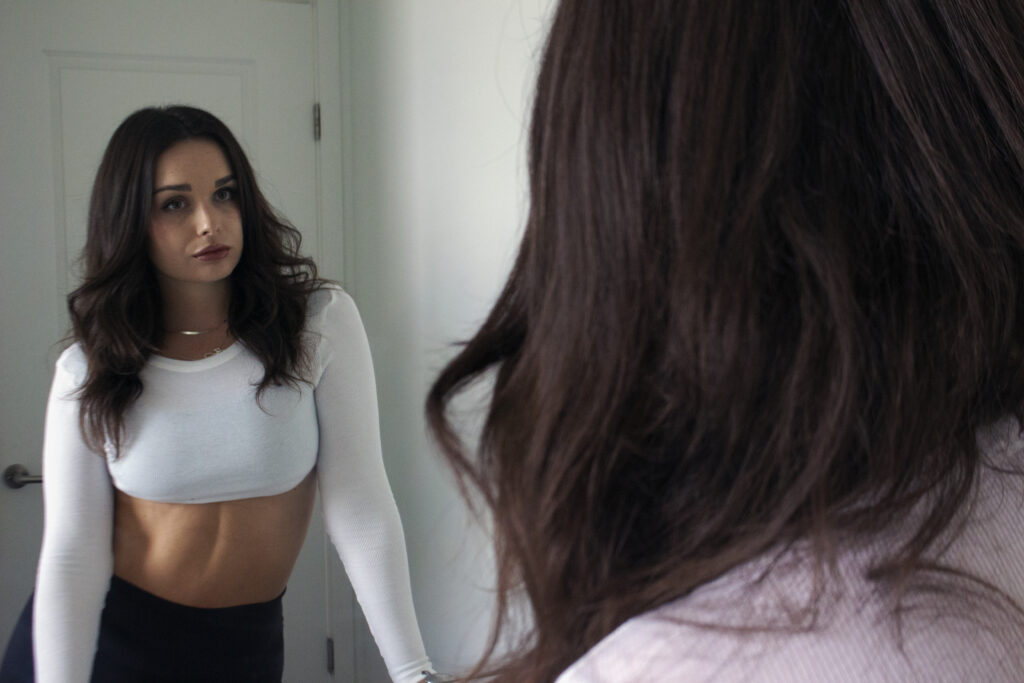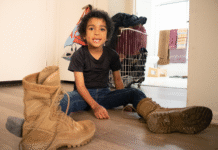A former model tackles the challenges of an eating disorder

Stepping into the elevator with a lump in her throat and feeling the urge to throw up, there was nothing she could do that would stop her entire body from shaking.
The feeling of being lightheaded from not eating or drinking water was taking over and the cloud of anxiousness filled her mind.
She continued questioning if she would be good enough for them this time.
Stress and fear filled Julia Kinports’ head going into her agency for the third time after being told she needed to lose inches around her hips if she wanted to be a working model.
She walked down the long narrow hallway that had walls filled with photos of the agency’s top successful models. It was hard for her not to get discouraged, wishing her photo was on that wall.
What if I’m not good enough? What if I’m still not skinny enough? There were so many “what if” questions that she continuously asked herself moments before walking in to get her measurements taken.
As she walked through the door of the office’s open air floor plan, all of the agents looked up from their computer screens at her. She knew immediately it was time to put on the fake smile and pretend that everything was fine.
“I remember leaving in tears that day. From there, I had no idea what to do. I was already emotionally unstable and making myself throw up,” Kinports said.
This is not an atypical life for a 19 year-old model starting in the industry. Kinports is not alone. According to the National Eating Disorders Association, 40% of models starting in the industry struggle with some sort of eating disorder.
Kinports, a 25 year-old former model, started submitting herself to agencies six years ago. But she developed an unhealthy relationship with food in the seventh grade.
“It really started progressing over the years to where I didn’t even think about what I was doing to myself,” she said. “It was just something that I did.”
She submitted digitals (raw, unedited photos) of herself to agencies through email and on Instagram. She submitted to top agencies, including IMG Models and Wilhelmina Models, along with boutique agencies that represent a smaller roster and focus more on development.
That’s when she caught the eyes of modeling scouts.

“Once I got the meeting with my agency and got signed, they slammed me with everything that I needed to change,” Kinports said. “The agents told me that I needed to grow my eyebrows out, take my extensions out, dress differently and lose three inches off my hips. They wanted me to be a 24-inch waist.”
Already struggling with an eating disorder, her new found career made it worse.
“I was already making myself throw up before, but when they slammed me with all the things I needed to fix about myself, that triggered me,” Kinports said.
Once the contract was signed and in place, she knew what they were expecting. She convinced herself that this was a normal thing people do in the industry.
“I literally had to stop eating to get to where I needed to be,” Kinports said. “If I did eat, I would have to expunge it from my body.”
It didn’t take long for Kinports to start testing and working. Testing is where photoshoots are set up by the agency to get industry level images for a portfolio.
“When I had a job, I wouldn’t eat the three days before,” Kinports said. “I wouldn’t even drink water 24 hours prior to the shoot.”
After a couple of months in the industry, Kinports was eating as little as possible to try to reach her agency’s desired measurements.
“I was basically eating only fruits and nuts and it wasn’t working,” Kinports said. “I went back to my agency for updated measurements, and my agent told me that I gained an inch around my hips. I left in tears that day.”
Often, the only way to deal effectively with eating issues is with professional help. Christy Siebert, a health and nutrition specialist, has guided many people through the process, which she said often begins subconsciously.
“People in the modeling industry don’t intentionally say, ‘I’m going to be or become anorexic or bulimic.’ It starts off with them being told something or noticing that people are smaller than they are, or this is what they need to do to get a job,” Siebert explained. “They are constantly putting more and more notes in the back of their head, and it becomes a place of anxiety driven thoughts about food. And all of a sudden, the box starts getting smaller and smaller until they are barely—or not—eating.”
Siebert also believes the industry often hides the issues of eating disorders.
“When in a culture like Los Angeles and an industry like modeling where every person’s body type looks the same, they don’t think that they have the problem,” Siebert said. “Half the time, models in the industry don’t even realize that what they are doing is really hurting them. It’s a never ending cycle of fear and anxiety.”
Struggling with an eating disorder doesn’t just affect the relationship with food. It negatively impacts the overall health of an individual.
“There is a correlation between being undernourished and it impacting your mental health. It exacerbates what’s going on,” Siebert said. “If these models aren’t eating enough, they aren’t thinking clearly. This is making them more anxious and depressed. It almost encourages what is going on because they aren’t in the right headspace to realize what they are doing to themselves.”
From the time Kinports started modeling, she lost a significant amount of weight. Her entire body shape changed.
“I went from having an athletic built body to looking ill,” Kinports said. “My sophmore year of high school I weighed 160 pounds. Flashforward to me being 20, I weighed 106 pounds. I was not okay. I couldn’t even tell how skinny I was. My body dysmorphia was so bad.”
No matter how many jobs she was booking or comments she received about how skinny she was, it wasn’t good enough.
“The one person in the industry you want validation and acceptance from is your agent,” Kinports said. “You want them to be happy with you. And when that one person is telling you that you still aren’t good enough and need to improve, it makes your spiral.”
Storm LA Model Agent Ryan Kocol focuses on new faces, development and portfolios. He believes that the problem is complicated.
“I feel that there are times it’s the model that has expectations they set for themselves because they think it’s what the agency wants,” Kocol said. “Sometimes it’s the agents and how they approach the conversation. The industry can definitely start new conversations in the models’ heads and cause mental health and eating issues.”
Kocol explained that agents often don’t realize how talking to models about weight can impact them and that models need to look out for themselves.
“At the end of the day, it’s all about the model understanding what is best for them, who is best for them, and getting into that routine throughout their career.” he said.
After three months, Kinports got a call from her agent saying that she needed to come back to the office to get her measurements updated.
“The first thing my agent said when I walked in was, ‘Oh wow, what have you been doing? You look so good,’ and for a minute I felt relieved,” she said. “Then they took my measurements and said to me, ‘Wait, don’t go all New York on us. You’ve lost too much weight now.’ I was devastated.”
Following that meeting with her agency, Kinports asked to part ways, because she knew it was essential for her mental and physical health.
“Even after I left the industry and started going to therapy, I still had this horrible image of myself,” she said. “It took me three years to cope with what I was doing. You don’t see yourself getting that thin, but everyone else is noticing that you are physically unwell. You go through so much to hide and normalize it and make the issue seem like it’s not a problem.
“But when your friends and family start noticing that you are really underweight and saying things to you, that’s when you take a step back and understand how wrong it all is.”
Kinports sought therapy to guide her through the beginning stages of healing. From there, she changed her habits and stopped putting herself in triggering situations. She started listening to her body and slowly fixed her relationship with food.
“I am much happier and healthier than I ever was and way more comfortable with myself,” Kinports said. “My eating disorder is still something I think about all the time. It’s a mental battle that I am fighting to this day.”



